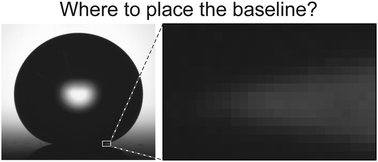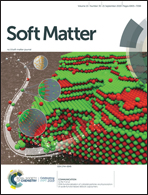Uncertainties in contact angle goniometry†
Abstract
The most widely used method to quantify the wetting properties of surfaces is by measuring contact angles. Even though contact angle goniometry is a powerful technique for characterizing wetting properties, it is not accurate for very hydrophobic surfaces. As the technique relies on image processing, it has inherent errors due to optical limitations, especially near the three-phase contact line. This leads to uncertainties in the positioning of the baseline, which can cause large errors in the measured contact angles. In this paper, we systematically evaluate these errors both theoretically and experimentally, focusing on the importance of image resolution. For ∼9 microliter droplet, displacement of the baseline by a single pixel leads to errors of approximately ±0.5° to ±1° for contact angles up to 150°, and errors increase rapidly in the superhydrophobic regime, up to ±8°. The error in the contact angle can be slightly reduced by increasing the image resolution, but cannot be eliminated entirely.



 Please wait while we load your content...
Please wait while we load your content...